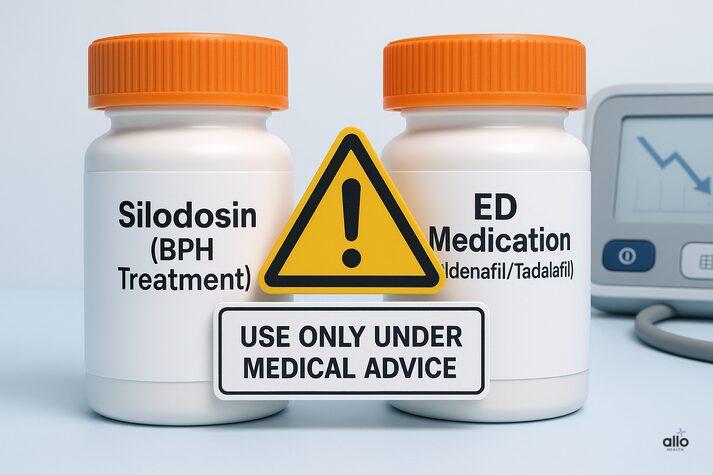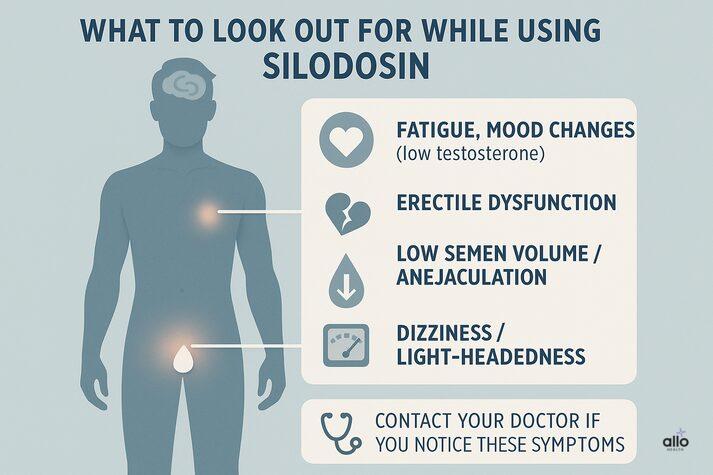Silodosin and Erectile Dysfunction: How Silodosin Affects Sexual Performance

Silodosin rarely causes erectile dysfunction. Most men who take it for benign prostatic hyperplasia (BPH) maintain normal erections. The main sexual side effect is ejaculatory dysfunction, such as reduced semen or no ejaculation, not erectile issues. In a few cases, mild or temporary ED may occur due to muscle relaxation or emotional factors, but it usually improves once the medication is stopped or the dose is adjusted under medical guidance.
Many men taking medication for benign prostatic hyperplasia (BPH) worry about its possible impact on sexual health, especially erection the quality. One common question amongst patients being treated for prostate disease is: Can silodosin cause erectile dysfunction?
Silodosin rarely causes erectile dysfunction. Its main sexual side effect is ejaculatory problems, not erection issues. In rare cases, mild ED may occur due to muscle relaxation or emotional factors, but it usually improves after stopping the medication.
In this article, we’ll explore what the research really says, how silodosin affects erectile function, and what you can do if you experience any side effects.
Does Silodosin Cause Erectile Dysfunction?
Silodosin rarely causes erectile dysfunction as a primary side effect. Most studies show that men using silodosin for prostatic hyperplasia generally maintain healthy erectile function. The main sexual side effect is actually ejaculatory dysfunction, not ED.
A study found that patients experience some change in ejaculation, commonly anejaculation, which means absence of semen during orgasm, or a noticeable reduction in seminal volume. [1] Another study shows that about 70% of men on silodosin reported anejaculation, with 17% also reporting impaired erectile function. [2]
Many patients mistake ejaculatory changes for erectile dysfunction. Silodosin mainly affects how semen is released but can sometimes cause ED.

How Does Silodosin Cause Erectile Dysfunction?
Silodosin works by relaxing the muscles and improving blood flow in the prostate and bladder area, helping relieve lower urinary tract symptoms. [3]
When these muscles relax:
- The male reproductive organs, like the seminal vesicles and vas deferens, fail to contract properly, leading to ejaculatory issues.
- In rare cases, it may subtly influence erectile function by either reducing the rigidity of the erection or by delaying it.
Another indirect factor is psychological. Men who worry about possible sexual side effects may actually experience them because of a “nocebo effect,” where negative expectations trigger real symptoms. [4]

Can Silodosin Be Used With ED Medication?
Combining silodosin with erectile dysfunction drugs like sildenafil, tadalafil, avanafil, or vardenafil should be done only under medical advice. Both classes of medications relax blood vessels and may lower blood pressure, which can trigger orthostatic hypotension, a sudden drop when standing up, leading to dizziness or fainting.[5] If your doctor approves their use, they’ll likely recommend starting with the lowest dose and monitoring blood pressure closely.

What to Look Out For While Using Silodosin
Stay aware of both urinary and sexual changes. You should contact your doctor if you experience:
- Noticeable decrease in ejaculate volume or complete anejaculation
- Reduced sexual functioning or desire
- New-onset erectile dysfunction
- Symptoms of low testosterone, like reduced sex drive, fatigue, and mood changes
- Dizziness or light-headedness (possible blood pressure changes.

How to Manage ED Caused by Silodosin
If you suspect the drug is affecting erections, don’t panic and don’t stop it abruptly. Here’s what helps:
- Talk to your urologist. They can evaluate whether the issue stems from the medicine or another cause, like stress, low testosterone, or vascular disease.
- Dose adjustment. A trial period with a reduced dose (4 mg) can often restore sexual comfort while controlling prostate disease.
- Switch if needed. Alternatives such as tamsulosin or alfuzosin may provide similar relief with fewer sexual effects.
- Lifestyle support. Exercise, adequate sleep, and a balanced diet improve blood vessel health and sexual function.
- Short-term ED therapy. Under supervision, PDE-5 inhibitors may help until symptoms resolve.
Never make these changes on your own. Every adjustment should be done only under a doctor’s guidance to avoid complications or unwanted side effects.
Conclusion
Silodosin is highly effective for relieving lower urinary tract symptoms of benign prostatic hyperplasia, but it can cause ejaculatory dysfunction in many men and erectile dysfunction in a small minority. The effects are reversible, rarely serious, and should always be discussed with your healthcare provider. With the right medical guidance, sexual function and prostate health can both be maintained safely.
"The following blog article provides general information and insights on various topics. However, it is important to note that the information presented is not intended as professional advice in any specific field or area. The content of this blog is for general educational and informational purposes only.
Book consultation
The content should not be interpreted as endorsement, recommendation, or guarantee of any product, service, or information mentioned. Readers are solely responsible for the decisions and actions they take based on the information provided in this blog. It is essential to exercise individual judgment, critical thinking, and personal responsibility when applying or implementing any information or suggestions discussed in the blog."






